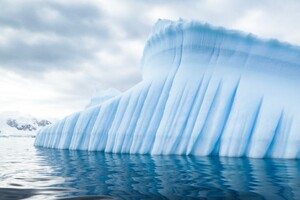The melting of the glacier can raise the level of the world ocean by several meters.

Scientists stated that the Antarctic Doomsday Glacier, so named because of the high risk of collapse and rising global ocean levels, is likely to retreat in the near future. This adds to concerns about the extreme rise in sea levels that will accompany its demise, CNN reports.
The underwater base of Thwaites Glacier is collapsing as the planet warms due to global warming. In the course of the study, the results of which were published in the journal Nature Geoscience, scientists mapped the retreats of the glacier that were observed in the past. In this way, they hoped to learn about probable future scenarios.
Read also: Abnormal temperatures have critically accelerated the melting of Greenland's glaciers
It turned out that at some point during the last 200 years, the ice sheet had moved away from the sea floor and was retreating at a rate of 2.1 kilometers per year. This is twice the rate that scientists have observed in recent decades.
Scientists suggest that this rapid retreat could have occurred “no later than the middle of the 20th century.” This means that Thwaites Glacier could potentially retreat rapidly in the near future once it recedes behind the ridge of the seafloor, which helps keep it in check.
The Thwaites Glacier is located in West Antarctica and is one of the widest on Earth. But it is only part of the Antarctic ice sheet. It contains enough ice to raise sea level by 4.8 meters. As the climate crisis intensifies, the region is under intense scrutiny from scientists due to rapid melting and the potential for rapid coastal erosion.
The Thwaites Glacier itself has been a concern of scientists for several decades. As early as 1973, researchers began to question whether there was a risk of the glacier collapsing. A few decades later, scientists found out that it is not adjacent to land, but to sea ice, so warm currents can melt the glacier from below, causing it to destabilize.
Because of this feature, researchers began to call the area around the Thwaites Glacier ” a weak inversion of the West Antarctic ice sheet”. In the 21st century, scientists began to document the rapid retreat of the glacier.
In 2001, researchers found that the ground line recedes by about a kilometer a year. In 2020, evidence was found that warm water is indeed washing away the base of the glacier. And in 2021, it turned out that the Thwaites Ice Shelf, which helps to stabilize the glacier and keep it from flowing freely into the ocean, could collapse within five years.
Related video
Remember, data from the European satellite system Copernicus showed that the last seven years were the hottest in the history of observation. Last year, 2021, became the fifth hottest year on the list, with temperature records set in some regions.
See special topic: Extreme heat can make most of the planet uninhabitable by 2100 This will happen even if warming can be stopped within two degrees Celsius. Scientists suggested giving names to heat waves The first one has already been named, she was named Zoya. Scientists spoke about the future of the largest ice sheet of the Earth As early as 2100, the sea level may rise by half a meter. Climate changes make infectious diseases more dangerous – scientists In the near future, it is necessary to closely monitor 277 known diseases. Climate change could destroy human civilization – scientists Researchers urge to prepare for the worst scenario of global warming.




